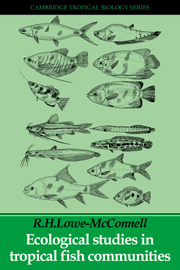10 - Pelagic fishes
Published online by Cambridge University Press: 07 May 2010
Summary
Production in the pelagic zone of tropical seas is very patchy, greatest in upwelling areas and convergence zones, often with much variation seasonally and from year to year. The resources are exploited by fishes in two main ways: (1) by small species with short cycles (such as clupeoids) which multiply fast, so producing many mouths to exploit planktonic food when it is abundant; (2) in larger species (such as tuna) by migrating long distances in search of food. Adaptations to life in the pelagic zone include schooling which helps the fishes to keep together when moving in the vastness of the open ocean, as well as providing protection from predation in the small species. Physostome swimbladders enable the fishes to migrate vertically with ease (which physoclistous fishes cannot do). The uniform silvery colouration of the openwater fishes is linked with an environment that is visually uniform except for light intensities varying with depth and time of day. The acoustico–lateralis system of clupeoids, linked with the swimbladder, enhances sensitivity to water vibrations and so aids synchronous swimming (Blaxter & Hunter, 1982).
Clupeoid fishes of upwelling areas
Clupeoids are among the world's most important food fishes; in 1971 they made up 35% of world landings, and the fourfold increase in catches since 1958 was mainly due to increased landings of clupeoids from low–latitude waters, particularly those of the Peruvian anchovy fishery.
- Type
- Chapter
- Information
- Ecological Studies in Tropical Fish Communities , pp. 226 - 232Publisher: Cambridge University PressPrint publication year: 1987



